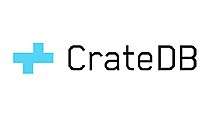CrateDB
CrateDB is a distributed SQL database management system that integrates a fully searchable document-oriented data store. It is open-source, written in Java, based on a shared-nothing architecture, and is designed for high scalability and includes components from Presto, Lucene, Elasticsearch and Netty.
 | |
| Developer(s) | Crate.io, Inc. |
|---|---|
| Written in | Java |
| Operating system | Cross-platform |
| Type | Data Store |
| License | Apache License 2.0 |
| Website | crate |
History
The CrateDB project was started by Jodok Batlogg, an open source contributor and creator who has contributed to the Open Source Initiative Vorarlberg[1] while at Lovely Systems in Dornbirn. The software is an open source, clustered database used for fast text search and analytics.[2] The company, now called Crate.io, raised its first round of financing in April 2014,[3] a $4M round in March 2016,[4] and a $2.5M round in January 2017 from Dawn Capital, Draper Esprit, Speedinvest, and Sunstone Capital.[5]
In June 2014, Crate.io won the judge's choice award at the GigaOm Structure Launchpad competition[6][7] and in October 2014, they win the TechCrunch Disrupt Europe in London.[8][9]
CrateDB 1.0 was released in December 2016.[2][10][11] and was reported to have had more than one million downloads.[10] CrateDB 2.0 and an Enterprise Edition was released in May 2017.[12][13][14]
Overview
CrateDB's language is SQL but it uses the document-oriented approach of NoSQL style databases. The software uses the SQL parser from Presto, its own query analysis and distributed query engine. Elasticsearch and Lucene is used for the transport protocol and cluster discovery and Netty for asynchronous event driven network application framework.[15]
CrateDB offers automatic data replication and self-healing clusters for high availability.
CrateDB includes a built-in Administration Interface. The Command Line interface (Crate Shell – CraSh) allows interactive queries. Its Python client is most advanced and features SQLAlchemy integration.
References
- Franz Rüf, Clemens Peter, Jodok Batlogg, Roland Alton-Scheidl (eds.): Open Source Initiative Vorarlberg. Perspektiven für Wirtschaft, Bildung und Verwaltung, 2005.
- "CrateDB packs NoSQL flexibility, SQL familiarity" InfoWorld. Dec. 19, 2016
- "Open Source Data Store Startup Crate.io Raises $1.5M From Sunstone And DFJ Esprit". TechCrunch. 24 April 2014. Retrieved 2014-07-22.
- http://www.finsmes.com/2016/03/crate-technology-raises-4m-in-funding.html
- http://www.finsmes.com/2017/01/crate-io-raises-e2-5m-in-seed-funding.html
- Nacheva, Mina (24 June 2014). "Crate.io wins at 2014 Launchpad competition". inventures.eu. Archived from the original on 11 June 2015. Retrieved 2014-07-22.
- "Vorarlberger Startup Crate.io ausgezeichnet". Vorarlberg Online. Retrieved 2014-07-22.
- "Crate.io: Vorarlberger gewinnen bei Techcrunch Europe". Horizont. Retrieved 2014-10-30.
- "Vorarlberger Start-up Crate.io gewinnt Techcrunch Europe". Futurezone. Retrieved 2014-10-30.
- Claburn, Thomas (16 December 2016). "Crate.io unboxes clustered SQL CrateDB, decamps to California". www.theregister.co.uk.
- "CrateDB: The IoT and machine data-focused database" NetworkWorld. Dec 14, 2016
- "CrateDB 2.0 Enterprise stresses security and monitoring—and open source" InfoWorld. May 16, 2017
- "Crate.io Packs New Features, Services Into DB Upgrade" LinuxInsider. May 17, 2017
- "With version 2.0, Crate.io’s database tools put an emphasis on IoT" TechCrunch. May 16, 2017
- Claburn, Thomas (14 December 2016). "Crate.io unboxes clustered SQL CrateDB, decamps to California". The Register.